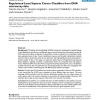NAR
2010
13 years 9 months ago
2010
Cancer-related investigations have long been in the limelight of biomedical research. Years of effort from scientists and doctors worldwide have generated large amounts of data at...
BMCBI
2010
13 years 11 months ago
2010
Background: Colon cancer is driven by mutations in a number of genes, the most notorious of which is Apc. Though much of Apc's signaling has been mechanistically identified o...
BMCBI
2004
14 years 2 months ago
2004
Background: A central challenge in the molecular diagnosis and treatment of cancer is to define a set of molecular features that, taken together, distinguish a given cancer, or ty...
CANDC
2005
ACM
14 years 2 months ago
2005
ACM
A DNA microarray can track the expression levels of thousands of genes simultaneously. Previous research has demonstrated that this technology can be useful in the classification ...
BMCBI
2005
14 years 2 months ago
2005
Background: The advent of the technology of DNA microarrays constitutes an epochal change in the classification and discovery of different types of cancer because the information ...
BMCBI
2005
14 years 2 months ago
2005
Background: The extensive use of DNA microarray technology in the characterization of the cell transcriptome is leading to an ever increasing amount of microarray data from cancer...
NAR
2008
14 years 2 months ago
2008
Cancer is ranked as one of the top killers in all human diseases and continues to have a devastating effect on the population around the globe. Current research efforts are aiming...
IJCSA
2006
14 years 2 months ago
2006
According to statistics, the rate of having cancer is relatively high for people in developing and developed countries. So cancer can be called as the enemy of human health. With ...
BMCBI
2006
14 years 2 months ago
2006
Background: Prostate cancer is one of the leading causes of cancer illness and death among men in the United States and world wide. There is an urgent need to discover good biomar...
ALIFE
2006
14 years 2 months ago
2006
Cancer can be viewed as the loss of cooperative cell behaviors that normally facilitate multicellularity, including the formation of tissues and organs. Hanahan and Weinberg descri...

